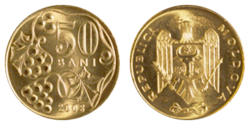A first series of mostly small aluminum coins entered circulation in November 1993. A second series consisting of larger denomination coins was issued in 2018. Most Moldovan coins are minted at the Monetăria Statului in Romania.
First series (1993–present)
In November 1993, the National Bank of Moldova (NBM) issued its first coins of 1, 5, 25 and 50 bani and 1 and 5 lei. [7]
The 1 and 5 lei coins were withdrawn from circulation in 1994. [8] Due to their low quality and relatively high nominal value, many forgeries appeared.
In April 1996, a 10 bani coin was introduced. [9]
In 1997, the NBM announced that it would replace the existing aluminum 50 bani coin with a new one made from brass-plated steel with a new and improved design featuring anti-counterfeit elements such as reeding, a first for modern Moldovan coins.
The new 50 bani coins were put into circulation on 2 February 1998. At the same time the NBM began withdrawing old aluminum 50 bani coins. [10] They were demonetized on 1 January 1999.
1 ban coins remain legal tender but are rarely used or seen in circulation, effectively leading to "Swedish rounding". [11]
| Coins of the first series (1993–present) [12] |
|---|
| Image | Value | Technical parameters | Description | Date of |
|---|
| Diameter | Mass | Composition | Edge | Obverse | Reverse | minting | issue | withdrawal | lapse |
|---|
 | 1 ban | 14.5 mm | 0.67 g | Aluminum | Plain | Denomination, year of minting | Coat of arms, country name | 1993~2017 | 29 November 1993 | Current, but not issued for general circulation |
 | 5 bani | 16 mm | 0.75 g | 1993~2018 | Current |
 | 10 bani | 16.6 mm | 0.85 g | 1995~2018 |
 | 25 bani | 17.5 mm | 0.95g | 1993~2020 |
 | 50 bani | 19 mm | 1.07 g | 1993 | 1 January 1999 |
 | 50 bani | 19 mm | 3.1 g | Brass-plated steel | Reeded | Grapevine with grapes and leaves, denomination, year of minting | 1997~2018 | 2 February 1998 [13] | Current |
 | 1 leu | 20,1 mm | 3,3 g | Nickel clad steel | Plain | Denomination, year of minting | 1992 | 29 November 1993 | 1994 |
 | 5 lei | 22,0 mm | 3,6 g | 1993 |
| These images are to scale at 2.5 pixels per millimetre. For table standards, see the coin specification table. |

































